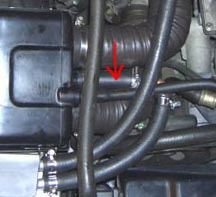- BACK page1 page2 page3 page4 page5 page6
- Oil Catch Tank
- So how des it all perform ?......I have no idea ;-)
- First I need to take some readings of the pressures and vacuums which exist
- in the engine while being driven at various loads and rpm's with standard fitment.
- Sometime later................. .
- I expected to see positive crank pressure, at reasonable engine load, perhaps the vacuum
- generated in the sump is due to the pull of air from inside the airbox sucking air out of the
- engine when in boost. If this is the case then we have "negative boost" right at the airbox,
- ok not much, but still at least 0.39 psi, I'm guessing that the vacumm at the airbox is
- going to be higher than this at boost because I was was measuring at the dipstick tube
- and there must be losses from the airbox to dipstick tube. I need to measure what is
- happening inside the airbox.
- I don't really want to drill into the airbox, I think if I tap into this pipe the readings will be as good,
- however I have a feeling I'll need to measure the airbox directly when I start to experiment with the
- exit tube size of the green filter device inside.

- 2. Catch tank connected.
- Results:-
- Cruise, over run, sump at atmosphere.
- Accelerator hard down revealed momentary positive pressure to about 4" water
- (0.144psi) which dropped to vacuum at about 9" water (0.325psi) 5.5krpm, boost 0.7bar
- I wanted to see the same result as test 1, but as there is more plumbing connected I'm
- not really surprised to see a difference, it's not much in real terms. I've effectively added more
- resistance to airflow, the "suck" from the airbox (if that is really what's going on) has to work
- harder to pull air through the tank and extra pipe work to this could account for difference at
- the dipstick tube. Then I remembered the aluminium restrictor located in the connection to the
- airbox, this had a bore size of about 10mm, so I removed it and ran test 3.
-
- 3. Catch tank connected, restrictor removed.
- Results:-
- Cruise, over run, sump at atmosphere.
- Accelerator hard down revealed momentary positive pressure to only about 0.5" water
- (0.018psi) then steady drop to 11" water (0.39 psi) vacuum with revs to about 5.5krpm,
- boost 0.7bar. I did manage an extended bit of foot hard down and the vacuum rose to
- about 13" water (0.469psi) vacuum, boost just over 0.7bar.
- Removing the restrictor has made up for the losses created by the tank and pipe work.
- Thinking ahead slightly, one of the objectives is to create some vacuum in the sump at
- idle, to do this may require partially blocking the exit hole in the green filter in the air box,
- I think this will reduce the vacuum at boost levels in the sump, at least without some sort of
- one way flappy valve type job.......???
Sometime even later.........
Fixed a small length of rubber tube to make the vent from the green filter into the airbox lid smaller by approx 50%, also made better seal of the pipes from green filter to airbox lid.
With standard setup, allowing the engine to get hot at idle would produce loads
of smoke when blipping the throttle. When driving the smoke would totally
clear.
With tank connected, started engine and allowed to tickover until operating
temp, there was no smoke produced at all, even when allowed to further tickover for about another 10 minutes there was just a little steam vapour. So far that’s a promising result but until it’s done a few cold starts idle to hot without smoke I’m not holding my breath because the LC can be very tempermental.
Connecting the gauge to the sump, I got about 1” water of vacuum (0.036psi), compared to nothing when std set up at hot idle.
Out for a quick run up the road, at cruise there was about the same vacuum ie 0.36psi, foot hard down this changed to about 5” water (0.18psi) positive pressure, which then changed to 6” water (0.216psi) vacuum by the time full boost was achieved, whereas before vac rose to about 11” (0.397psi)
I’m pretty sure we cannot have our cake and eat it in terms of having vacuum in the sump at idle and vacuum in the sump in boost conditions, without some sort of mechanical/ecu operated valve device….which is exactly what Malcolm has discovered in the ecu program code……having said that, in real terms the figures I’ve got so far are small………perhaps this is the reason the ecu operated valve was discontinued…………….
I have another experiment to try, which is to effectively connect the vacuum tube from the inlet manifold drirectly to the cam cover breather and see just how much vacuum would build up at idle.